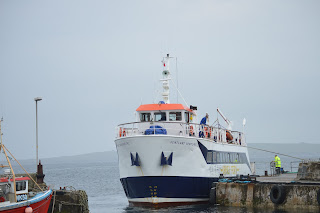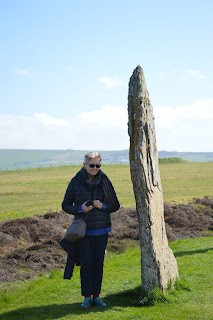Today we are hopeful that the weather will be kind to us. Here we are at the northern tip of Scotland. With any luck
today should be a highlight of the trip. Yesterday the ferry didn’t run because
it was too rough. A little overcast it wasn’t too bad and the passenger ferry from
the port of John O’Groats takes about an hour to get there. Our guide Martin has
lived on the island for three years and began there as a bus driver. When the
locals hopped on and told him their destination he had no idea what they were
saying as they speak in Gaelic. Rather than seem stupid he would just tell them
the fare was a pound. It didn’t help that the local knowledge that the village
of St Mary’s Hope is locally referred to as Ham.
Scapa Flow has been a major naval for the British Navy. At the end of World
War 1, while awaiting the conclusion of the Treaty of Versailles during 1919 the
German Fleet decided to scuttle their ships rather than surrender. Fighting
broke out and some 9 Germans were killed when the British tried to prevent the
scuttling. That’s why the local war memorial has a 1914-19 as the date on it.
During WW2 the Germans sent a U Boat into Scapa Flow to attack the
British fleet. There were many block ships sunk to prevent this from happening. There was one spot unguarded and there had been
a delay in sinking the ship, as the government was still arguing over the
price. The fleet was out except the WW1 Royal Oak which was too slow and was a
training ship largely for boys. The U-Boat fired four torpedoes of which three
left the vessel, two missed and the third hit the anchor chain. This alerted
the British but they did not know what happened. The scend salvo was more
successful and the ship was sank with 830 lives, mostly boys.
During the war Italian POWs were used to work to build what were called
Churchill barriers which also had the advantage of linking the islands. They
initially rightly refused, as it was war work. It was explained to them that it
was to help the farmers get produce to market and given more rations. They agreed. In their spare time they built a
chapel. It is quite remarkable, what they did with concrete, paint, bully beef
tins and old vehicle springs. It is unique.
Geographically the islands are subject to strong winds, these can last
a month. They have recorded 136 mph but
the anemometer broke at that point. Trees
don’t generally grow here because it is too windy, but where they do grow, houses
are actually windbreaks for trees. It's so windy that Orkney women only have two hair styles...a nor'wester or a sou'wester The islands are 5 degrees warmer than the
rest of the UK because of the warm Gulf Stream current. It doesn't now there despite being on the same latitude as Moscow.
They are self-sufficient in power by using wind farms. They actually have
to shut them off as they supply power to the mainland but they were supplying
so much power the cable melted.
Our visit to Skara Brae was an eye opener. We had no idea that it was right
on the coast. It has been a highlight of the trip.
Now it was the Ring of Brognar, originally 60 stones but now 27. Its purpose
is unknown but we think it was for festivals/meetings as the stone materials are
different and each represent different clans.
The capital Lerwick has the impressive St Magnus Cathedral which is the
most northerly cathedral in the UK. We also visited the local museum which was
quite good but we didn’t have much time to spend there.
More sheep than humans live in the Orkneys.
We did witness a Blackening. What happens is when someone gets married
the men go around in a ute drinking, banging the sides and throwing filth at
each other. The girls do exactly the same.



















No comments:
Post a Comment